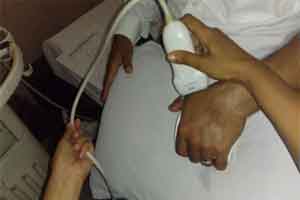- Home
- Editorial
- News
- Practice Guidelines
- Anesthesiology Guidelines
- Cancer Guidelines
- Cardiac Sciences Guidelines
- Critical Care Guidelines
- Dentistry Guidelines
- Dermatology Guidelines
- Diabetes and Endo Guidelines
- Diagnostics Guidelines
- ENT Guidelines
- Featured Practice Guidelines
- Gastroenterology Guidelines
- Geriatrics Guidelines
- Medicine Guidelines
- Nephrology Guidelines
- Neurosciences Guidelines
- Obs and Gynae Guidelines
- Ophthalmology Guidelines
- Orthopaedics Guidelines
- Paediatrics Guidelines
- Psychiatry Guidelines
- Pulmonology Guidelines
- Radiology Guidelines
- Surgery Guidelines
- Urology Guidelines
EULAR updated guidelines for musculoskeletal ultrasound

In 2001, the European League Against Rheumatism (EULAR) developed and disseminated the first guidelines for musculoskeletal (MS) ultrasound (US) in rheumatology. Fifteen years later, the dramatic expansion of new data on MSUS in the literature coupled with technological developments in US imaging has necessitated an update of these guidelines.
EULAR in order to update the existing MSUS guidelines in rheumatology as well as to extend their scope to other anatomic structures relevant for rheumatology undertook the project consisting of the following steps: (1) a systematic literature review of MSUS evaluable structures; (2) a Delphi survey among rheumatologist and radiologist experts in MSUS to select MS and non-MS anatomic structures evaluable by US that are relevant to rheumatology, to select abnormalities evaluable by US and to prioritise these pathologies for rheumatology and (3) a nominal group technique to achieve consensus on the US scanning procedures and to produce an electronic illustrated manual (ie, App of these procedures).
In the project structures from nine MS and non-MS areas (ie, shoulder, elbow, wrist and hand, hip, knee, ankle and foot, peripheral nerves, salivary glands and vessels) were selected for MSUS in rheumatic and musculoskeletal diseases (RMD) and their detailed scanning procedures (ie, patient position, probe placement, scanning method and bony/other landmarks) were used to produce the App. In addition, US evaluable abnormalities present in RMD for each anatomic structure and their relevance for rheumatology were agreed on by the MSUS experts.
Finally, the task force has produced a consensus-based comprehensive and practical framework on standardised procedures for MSUS imaging in rheumatology.
General recommended procedures for MSUS assessment in RMD
- MSUS includes two principal modes: B-mode (or grey scale) that provides us with morphological information of the anatomic structures and Doppler mode (colour Doppler or power Doppler) that allows us to evaluate blood flow.
- MSUS should be performed with high-resolution linear transducers (ie, probes) with frequencies between 6 and 14 MHz for deep/intermediate areas to ≥15 MHz for superficial areas.
- Tissue harmonic imaging, spatial compound imaging, extended field of view (panoramic) and virtual convex imaging are some of the software capabilities that may be useful in MSUS.
- When scanning a joint, the probe should be oriented as perpendicular or parallel to the bony cortical surface (bony acoustic landmark) so that the cortical margin appears bright, sharp and hyperechoic.
- A dynamic scanning technique by means of slight movements of translation (side-to-side, back-to-front), angulation and rotation of the probe should be carried out in order to allow the best visualisation of the structure(s) of interest.
- MS structures should be evaluated as they move smoothly either actively or passively.
- To avoid anisotropy (ie, hypoechoic/anechoic appearance of a normally hyperechoic structure that mainly affects tendons) and the common pitfalls that accompany it, the probe should be continuously adjusted to maintain the beam perpendicular to the tendon fibres especially in insertional regions.
- When the long axis of the structure of interest corresponds to the cranial-caudal orientation of the anatomic position, the most proximal aspect of the structure is usually placed on the left-hand side of the screen. However, other options are acceptable as long as the movement of the image on the screen is kept parallel to the direction of the probe on the patient. Our preference for short axis is to align the structure of interest on the screen as if the observer is looking at the patient.
- Probe compression can be helpful in distinguishing a compressible liquid collection from a non-compressible solid. Little or no compression is important when performing Doppler examination to avoid cessation of flow in small vessels.
- A generous amount of gel should be used for superficial structures especially when little or no pressure is indicated.
- The machine setting for B-mode and Doppler mode should be properly adjusted to optimise the US image acquisition process.
Over the last two decades, increasing numbers of rheumatologists worldwide have incorporated musculoskeletal (MS) ultrasound (US) into their clinical practice as both a valuable diagnostic and monitoring tool and a means to guide interventions (injections and biopsies). SUS is a multiplanar and dynamic imaging modality. It has a number of benefits over other imaging techniques; of particular note, it is safe and well tolerated by patients and provides point-of-care scanning allowing immediate and direct correlations between imaging findings and clinical data, which can improve the management of patients with rheumatic and musculoskeletal diseases (RMDs).
For more details click on the following link:
http://dx.doi.org/10.1136/annrheumdis-2017-211585

Disclaimer: This site is primarily intended for healthcare professionals. Any content/information on this website does not replace the advice of medical and/or health professionals and should not be construed as medical/diagnostic advice/endorsement or prescription. Use of this site is subject to our terms of use, privacy policy, advertisement policy. © 2020 Minerva Medical Treatment Pvt Ltd